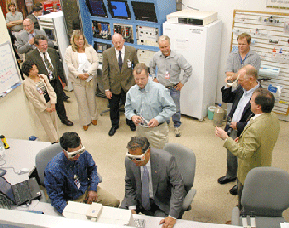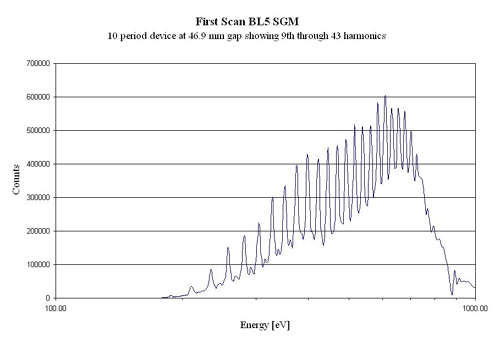

Contents of this Issue:
1. Science Highlight —
Nanomaterials Act Differently than Bulk Materials
(contact: Benjamin Gilbert,
bgilbert@eps.berkeley.edu)
Using synchrotron techniques, Benjamin Gilbert and his colleagues from the University of California Berkeley and LBNL have determined how the equilibrium structure and lattice dynamics of zinc-sulfur (ZnS) nanoparticles differed from bulk ZnS. They combined size and shape information from small-angle x-ray scattering (SAXS) with structure information from wide-angle x-ray scattering (WAXS) to analyze structural differences in the real-space pair distribution function. By combining SAXS and WAXS, they were able to remove the small-particle size contribution to x-ray diffraction peak broadening and quantify the excess disorder and strain in the nanoparticles relative to bulk ZnS. They observed an associated modification in materials properties by performing a temperature-dependent extended x-ray absorption fine structure (EXAFS) study of ZnS nanoparticles and bulk ZnS at the Zn K-edge. From a fit to the first-shell disorder, they determined that the ZnS nanoparticles were significantly stiffer than bulk ZnS.
Since nanoparticles may contain unusual forms of structural disorder that can
significantly modify materials properties, they cannot solely be considered as
small pieces of bulk material. This recent work develops a method to quantify
intermediate-range order in 3.4 nanometers zinc sulfide nanoparticles, and
shows that structural coherence is lost over distances beyond 2 nanometers. The
ZnS Einstein vibration frequency in the nanoparticles is substantially higher
than that in the bulk zinc sulfide, implying structural stiffening. This cannot
be explained by the observed 1% radial compression, and must be primarily due
to inhomogeneous internal strain caused by competing relaxations from an
irregular surface. The methods developed here are generally applicable to the
characterization of nanoscale solids, many of which may exhibit complex
disorder and strain. An article on this work was published in Science Express,
7/1/2004: To learn more about this work, see:
http://www-ssrl.slac.stanford.edu/research/highlights_archive/nano.
html
or
http://www-ssrl.slac.stanford.edu/research/highlights_archive/nano.pdf
2. Science Highlight —
Ordering in Thermally Oxidized Silicon
(contact: Sean Brennan,
bren@ssrl.slac.stanford.edu)
New evidence is overturning the assumption that the thermal oxide grown on single crystal silicon is completely amorphous. SSRL researchers Anneli Munkholm (now at Lumileds Lighting) and Sean Brennan recently published work in PRL showing that there is residual order within the oxide. The thermal oxide film on silicon has been studied extensively for decades because these oxides form the basis of most of the integrated circuits used in modern electronics. The new results have implications for theoretical models of the oxidation process.
The residual order was found in a wide range of oxidation recipes with oxide
thicknesses from 6 nanometers (nm) up to 100 nm, on silicon with different
surface orientations (Si(001) surfaces with and without miscut, as well as for
Si(011) and Si(111) surfaces). The new model depends on the silicon atoms
within the oxide becoming disordered while expanding towards the surface due to
injection of oxygen atoms into the silicon lattice. The expansion and the
disorder are smaller at the interface between the crystal and oxide film than
at the surface. The results can be used to determine the density of the oxide
as a function of its depth. The amount of residual order varies depending on
the oxidation recipe used, suggesting that the residual order can be
controlled. An article on this work was published in Phys. Rev. Letters (93,
036106, 2004). To learn more about this work, see:
http://www-ssrl.slac.stanford.edu/research/highlights_archive/oxidizedsi.
html
or
http://www-ssrl.slac.stanford.edu/research/highlights_archive/nano.pdf
3. Message from the SSRL Director - Keith
Hodgson
(contact: Keith Hodgson,
hodgson@ssrl.slac.stanford.edu)
I would like to share a few thoughts with you about SPEAR3 and developing opportunities for the future. This coming weekend will mark the end of the user commissioning run with SPEAR3. The accelerator performance has simply been spectacular for such a new and complex machine. Operational reliability (or % up time) is at 97% and users continue to give excellent reports of the impact of the high brightness and stability on the quality of data (see also item #6., below). We look forward to continuing improvements in performance (higher current and eventually top-off injection mode) in future runs. All the staff involved in SPEAR3 - accelerator, operations, beam lines, scientific, and supporting - deserve a tremendous amount of credit for their outstanding effort and dedication to make this effort such a success. In the area of linac-based light source development - SPPS continues to produce exciting results in both technical areas (e.g. accurate measurements of timing jitter) and science (e.g. time resolved studies of surface melting in semiconductors). Project engineering and design continues at a very rapid pace for LCLS and a recent external independent review contracted by DOE reported that the project costs and schedule were very reasonable. The LCLS science advisory committee (SAC) has reviewed the letters of intent that were submitted to SSRL (see also item #5., below) and we are now beginning to implement a plan for instrument/scientific development teams who will mount the first experiments on LCLS. We will soon begin to procure components for LCLS in FY2005 with conventional construction to begin in FY2006. All in all, it has been an exciting few months. We look forward to serving our user community even better with SPEAR3 and eventually LCLS, and thank you for continuing to do magnificent science at SSRL and supporting us and the other DOE synchrotron laboratories in public ways.
4. DOE Secretary Abraham Visits SLAC;
Launches STARS Program
On Thursday, July 8, U.S. Secretary of Energy Spencer Abraham made a return visit to SLAC. During his visit, Secretary Abraham toured several areas of the laboratory where scientists demonstrated ties between basic research and the development of technological innovations. On SSRL's part of the tour, the
 |
5. LCLS Scientific Advisory Committee Meets to
Review Proposals
(contacts: Keith Hodgson,
hodgson@ssrl.slac.stanford.edu)
The LCLS Science Advisory Committee (SAC) met on July 8-9, 2004 to review the
letters of intent that had been submitted to SSRL in response to a broad call
issued this past spring. The goal of this first step in the formulation of a
strategy for the initial phase of the LCLS scientific program was to solicit
the scientific community as broadly as possible for expressions of interest in
LCLS and its scientific program. LOIs were received in three categories - for
experimental programs, for single experiments and for technical developments.
The SAC reviewed all 32 LOIs that had been received and which included 256
independent investigators from 91 institutions. The SAC has just provided a
written report to SSRL and LCLS management that includes specific
recommendations for the scientific program to be developed for the first phase
of experiments on LCLS. We are now beginning to implement this strategy and
more detailed information will be forthcoming soon. Overall, the SAC and
SSRL/LCLS were very pleased with the excellent response of the community and
the outstanding nature of the proposals. It is a great beginning along the
road of what will lead to remarkable new opportunities for scientific discovery
as LCLS becomes operational in 2008. For more information on LCLS see:
http://www-
ssrl.slac.stanford.edu/lcls/
6. User Operations
(contact: Cathy Knotts,
knotts@slac.stanford.edu)
Other than a few sporadic power dips, SPEAR operations have been very stable throughout the month of July. The overall delivery rate for beam to users for this first SPEAR3 run will hit the 97% mark. To crown this remarkable achievement we are headed towards a 100% delivery for our final week of user operations. Another milestone was achieved on July 22, when light was brought through the new BL5-1/5-2 SGM. Very bright monochromatic light was seen on a phosphor screen after the exit slit, even with 1 micron entrance slits. The first energy scan of the mono with 10 micron entrance and 20 micron exit slits was done on July 23. The 10-period ID was in place at a gap of 46.9 mm (K = 5.25). The higher harmonics from this ID are quite sharp due to the low emittance of SPEAR3.
 |
7. SSRL Honors Bill Spicer by Creating a New Young
Investigator Award and Special Sessions at the October Users' Meeting
In honor of the many contributions of William E. Spicer to our community, SSRL has established the W. E. Spicer Award for scientific excellence. This new award will be given on an annual basis at the SSRL Users' Meeting to a young investigator who has made important technical or scientific contributions that benefit from or are beneficial to SSRL or the synchrotron research community. The award, which is open to senior graduate students and those within seven years of entry into their professional scientific field at the time of nomination, will consist of a certificate and a $1,000 prize. Nominations in the form of a letter or email summarizing the technical or scientific contributions of the candidate should be sent by the September 1, 2004 deadline to Cathy Knotts. Donations towards the W.E. Spicer Award can be sent by check made out to "Stanford University" to SSRL c/o Dave Dungan, SSRL MS69, 2575 Sand Hill Rd., Menlo Park, CA 94025. Please note "Spicer Award" on the memo line. For a brief summary of some of Bill's many contributions, see: http://www-ssrl.slac.stanford.edu/faculty/spicer.html
In addition to this award, a workshop (see Item #9., below) and a special session on the past and future of photoemission spectroscopy will be organized in conjunction with SSRL's 31st Annual Users' Meeting, October 20-22, 2004.
8. Call for Nominations for 2004 Lytle Award
(contact: Cathy Knotts,
knotts@ssrl.slac.stanford.edu)
Users are encouraged to submit nominations for the 2004 Farrel W. Lytle Award, which will be presented at the 31st Annual SSRL Users' Meeting. This Award was established in 1998 to recognize individuals for their promotion of important technical or scientific accomplishments in synchrotron radiation-based science and in fostering collaboration and cooperation in the use and applications of synchrotron radiation. The Lytle Award consists of a certificate and $1,000 prize. All SSRL users and staff are eligible for this award, but only nominations for individuals will be considered (no group awards). Letters of nominations summarizing the individual's contributions and why they should be recognized through this award should be forwarded before the September 10 deadline to knotts@slac.stanford.edu. For further information and previous winners of the Lytle Award, please see: http://www-conf.slac.stanford.edu/ssrl/2004/lytle.htm
9. Upcoming Seminars, Workshops, Meetings
|
Beam time requests for the first scheduling period of the 2005 experimental run, which is scheduled to begin on October 18, 2004, are due by August 13. Beam time at SSRL is extremely competitive, so it is important that you submit complete, detailed, and timely request forms. Beam time requests can be submitted electronically via our website:
__________________________________________________________________________
SSRL Headlines is published electronically monthly to inform SSRL users, sponsors and other interested people about happenings at SSRL. SSRL is a national synchrotron user facility operated by Stanford University for the U.S. Department of Energy Office of Basic Energy Sciences. Additional support for the structural biology program is provided by the DOE Office of Biological and Environmental Research, the NIH National Center for Research Resources and the NIH Institute for General Medical Sciences. Additional information about SSRL and its operation and schedules is available from the SSRL WWW site.
__________________________________________________________________________
To leave the SSRL-HEADLINES distribution, send email as shown below:
To: LISTSERV@SSRL.SLAC.STANFORD.EDU Subject: (blank, or anything you like)
The message body should read
SIGNOFF SSRL-HEADLINES
That's all it takes. (If we have an old email address for you that is forwarded to your current address, the system may not recognize who should be unsubscribed. In that case please write to ssrl-headlines-request@ssrl.slac.stanford.edu and we'll try to figure out who you are so that you can be unsubscribed.)
If a colleague would like to subscribe to the list, he or she should send To: LISTSERV@SSRL.SLAC.STANFORD.EDU and use the message body
SUBSCRIBE SSRL-HEADLINES
|
SSRL Welcome
Page | Research
Highlights | Beam Lines | Accel
Physics
User Admin | News & Events | Safety Office |